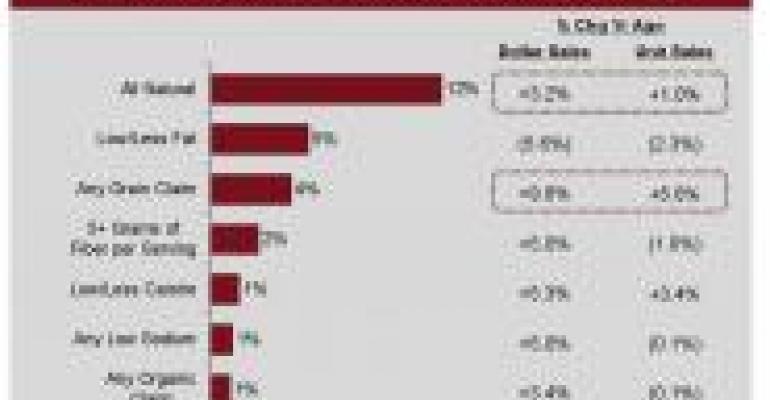CPG manufacturers and supermarket retailers can take a lot of credit for stimulating consumer interest in healthy eating. They’ve accomplished this during some pretty tough times, yet the latest numbers from Information Resources, Inc. show that demand for natural, organic and better-for-you foods continues to grow.
The chart at right shows some impressive bumps in sales and volume over the past year. Sales of products with any grain claim grew nearly 10% now account for 4% of edibles spending across the grocery, drug, mass merchandise and convenience channels. All natural claims are a factor in 12% of all food spending.
CPG marketers are making it happen by taking a new look at product development, marketing and merchandising. Product extensions have helped put healthful twists on conventional favorites, whether it’s adding whole grains to cereal or removing sodium from frozen dinners, according to the latest IRI Times & Trends report.
Thom Blischok, president of of IRI’s Shopper Marketing and Innovation division, notes that CPG manufacturers and retailers are also exploring merchandising opportunities. Here, successful strategies have included setting up discrete displays or kiosks where better-for-you products are displayed, cross-selling healthier products on packages of “traditional” products and selectively reducing prices.
“Behind any strategy should be a current and thorough understanding of the shopper, especially in today’s economy characterized by pockets of recovery and recession,” he writes. “How has the shopper changed? How have their behaviors evolved? How have their perceptions of value been affected? How do they define affordability today?”
The recession has dramatically changed the answers to those core questions. The part of the IRI report discussed above gives some indication of how shoppers are behaving. Better-for-you food and beverage options might be fairly well-entrenched across consumer segments, but significant upward potential remains. CPG marketers have the opportunity to drive gains through educational programs and price-value marketing strategies, the report concludes.
“Because motivating and mitigating factors for wellness-related purchases vary rather across and within consumer segments, it is critical that programs are knowledge based and keenly tailored and targeted.”

